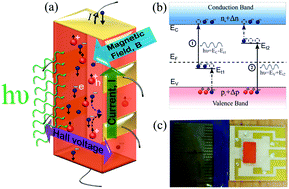Deep levels, charge transport and mixed conductivity in organometallic halide perovskites†
Abstract
Understanding the type, formation energy and capture cross section of defects is one of the challenges in the field of organometallic halide perovskite (OMHP) devices. Currently, such understanding is limited, restricting the power conversion efficiencies of OMHP solar cells from reaching their Shockley–Queisser limit. In more mature semiconductors like Si, the knowledge of defects is one of the major factors in successful technological implementation. This knowledge and its control can make a paradigm shift in the development of OMHP devices. Here, we report on deep level (DL) defects and their effect on the free charge transport properties of the single crystalline methylammonium lead bromide (MAPbBr3) perovskite. To determine DL activation energy and capture cross section, we used photo-Hall effect spectroscopy (PHES) with enhanced illumination in both steady-state and dynamic regimes. This method has shown to be convenient due to the direct DL visualization by sub-bandgap photo-excitation of trapped carriers. DLs with activation energies of EV + 1.05 eV, EV + 1.5 eV, and EV + 1.9 eV (or EC − 1.9 eV) were detected. The hole capture cross section of σh = 4 × 10−17 cm2 is found using photoconductivity relaxation after sub-bandgap photo-excitation. Here, our experimental results demonstrate the existence of DL defects responsible for non-radiative recombination and their positions inside the bandgap for the first time. Additionally, the transport properties of single crystal MAPbBr3 are investigated by Time of Flight (ToF) measurements at several biases. These measurements further confirm the increase of Hall mobility and the enhancement of hole transport produced by sub-bandgap illumination in MAPbBr3 devices. The analysis of charge carrier transport by ToF measurements in combination with the energy of DLs identified by PHES can explain the long hole carrier lifetime in MAPbBr3 devices, while the electron carrier lifetime is largely affected by trap-assisted recombination. Here, our studies provide strong evidence for deep levels in OMHPs and open a richer picture of the role and properties of deep levels in MAPbBr3 single crystals as a system model for the first time. The deeper knowledge of the electronic structure of OMHPs could open further opportunities in the development of more feasible technologies. Indeed, knowledge of the exact positions of DLs is beneficial in controlling these defects by crystal growth modification to eliminate these defects as was done for classical inorganic semiconductors, for example, in Si, GaAs, and CdTe development.



 Please wait while we load your content...
Please wait while we load your content...